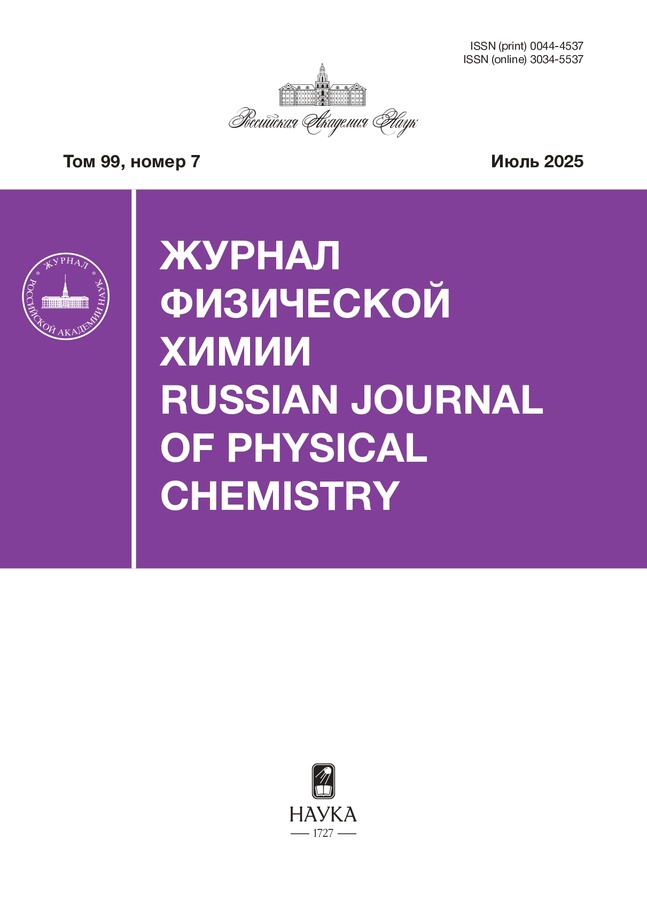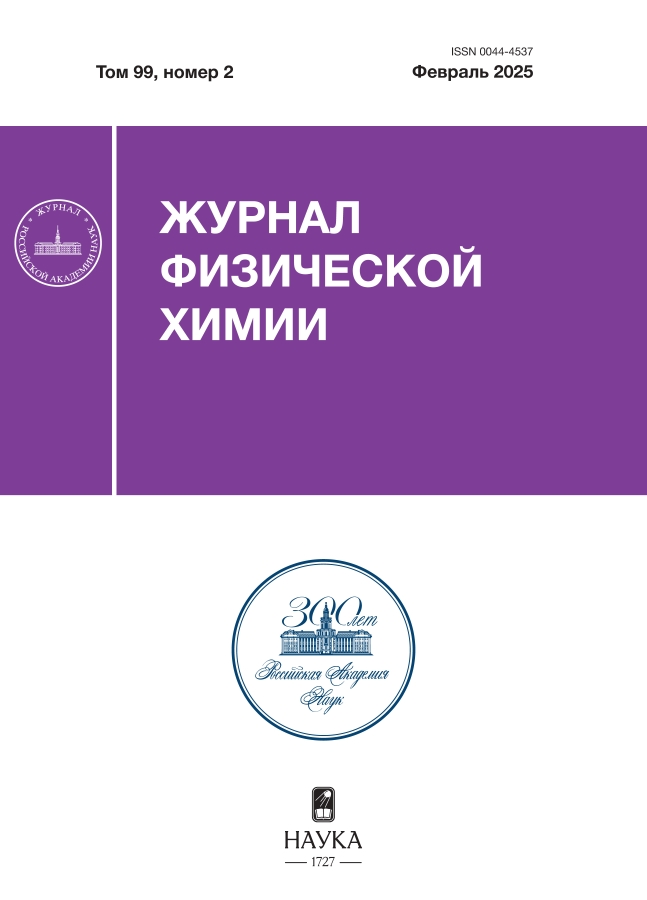Фотокаталитическое окисление щавелевой кислоты кислородом и озоном в водном растворе
- Авторы: Леванов А.В.1, Лапина А.В.2, Исайкина О.Я.1
-
Учреждения:
- Химический факультет МГУ имени М. В. Ломоносова
- Филиал МГУ имени М. В. Ломоносова в г. Баку
- Выпуск: Том 99, № 2 (2025)
- Страницы: 351-360
- Раздел: ФОТОХИМИЯ, МАГНЕТОХИМИЯ, МЕХАНОХИМИЯ
- Статья получена: 19.06.2025
- Статья опубликована: 20.05.2025
- URL: https://hum-ecol.ru/0044-4537/article/view/685286
- DOI: https://doi.org/10.31857/S0044453725020228
- EDN: https://elibrary.ru/DCPHUF
- ID: 685286
Цитировать
Полный текст
Аннотация
Выполнено экспериментальное исследование минерализации щавелевой кислоты Н2С2О4 и некоторых других устойчивых к окислению органических соединений в водном растворе под действием кислорода, озона и ультрафиолетового излучения. Обнаружено, что в кислых растворах Н2С2О4 не окисляется под действием озона или при УФ-облучении в присутствии кислорода; при одновременном воздействии О3 + УФ наблюдается окисление с малой скоростью. Изучена возможность фотокатализа процесса минерализации ионами Mn2+, MnO4–, Fe3+, Со2+, BrO3–, или IO3–. Наиболее эффективным фотокатализатором являются ионы Fe3+: в их присутствии и при УФ-облучении происходит достаточно быстрое окисление щавелевой кислоты до СО2 как под действием О3, так и О2. Найдены условия максимальной конверсии озона при фотоминерализации щавелевой кислоты. Показана возможность окислительной деструкции более устойчивого к окислению субстрата – уксусной кислоты – при озонировании и УФ-облучении растворов с добавками Fe(III) и Н2С2О4.
Ключевые слова
Полный текст
Об авторах
А. В. Леванов
Химический факультет МГУ имени М. В. Ломоносова
Автор, ответственный за переписку.
Email: levanovav@my.msu.ru
Department of Chemistry
Россия, МоскваА. В. Лапина
Филиал МГУ имени М. В. Ломоносова в г. Баку
Email: levanovav@my.msu.ru
Азербайджан, Баку
О. Я. Исайкина
Химический факультет МГУ имени М. В. Ломоносова
Email: levanovav@my.msu.ru
Department of Chemistry
Россия, МоскваСписок литературы
- Baird C., Cann M. Environmental Chemistry. 5 ed. New York: W.H. Freeman & Co., 2012.
- Beltran F.J. Ozone Reaction Kinetics for Water and Wastewater Systems. Boca Raton (Florida, USA): Lewis Publishers, CRC Press LLC, 2004.
- Lim S., Shi J.L., Von Gunten U., Mccurry D.L. // Water Res. 2022. V. 213. P. 118053.
- Marcì G., García-López E., Palmisano L. // J. Appl. Electrochem. 2008. V. 38. № 7. P. 1029.
- Bangun J., Adesina A.A. // Applied Catalysis A: General. 1998. V. 175. № 1. P. 221.
- Michael K.M., Rizvi G.H., Mathur J.N., Ramanujam A. // J. Radioanalyt. Nucl. Chem. 2000. V. 246. № 2. P. 355.
- Ganesh S., Desigan N., Chinnusamy A., Pandey N.K. // Ibid. 2021. V. 328. № 3. P. 857.
- Ананьев А.В., Тананаев И.Г., Шилов В.П. // Успехи химии. 2005. Т. 74. № 11. С. 1132. [Ananiev A.V., Tananaev I.G., Shilov V.P. // Russ. Chem. Rev. 2005. V. 74. № 11. P. 1039.]
- Von Sonntag C., Von Gunten U. Chemistry of Ozone in Water and Wastewater Treatment. From Basic Principles to Applications. London: IWA Publishing, 2012.
- Hoigné J., Bader H. // Water Res. 1983. V. 17. № 2. P. 185.
- Kuhn H.J., Braslavsky S.E., Schmidt R. // Pure Appl. Chem. 2004. V. 76. № 12. P. 2105.
- Parker C.A., Bowen E.J. // Proc. Roy. Soc. London A. 1953. V. 220. № 1140. P. 104.
- Hatchard C.G., Parker C.A., Bowen E.J. // Proc. Roy. Soc. London A. 1956. V. 235. № 1203. P. 518.
- Rabani J., Mamane H., Pousty D., Bolton J.R. // Photochem. Photobiol. 2021. V. 97. № 5. P. 873–902.
- Goldstein S., Rabani J. // J. Photochem. Photobiol. A. 2008. V. 193. № 1. P. 50.
- Леванов А.В., Исайкина О.Я., Грязнов Р.А. // Кинетика и катализ. 2022. Т. 63. № 2. С. 203. [Levanov A.V., Isaikina O.Y., Gryaznov R.A. // Kinetics and Catalysis. 2022. V. 63. № 2. P. 180.]
- Леванов А.В., Исайкина О.Я., Гасанова Р.Б., Лунин В.В. // Журн. физ. химии. 2017. Т. 91. № 8. С. 1307. [Levanov A.V., Isaikina O.Y., Gasanova R.B., Lunin V.V. // Russ. J. Phys. Chem. A. 2017. V. 91. № 8. P. 1427.]
- Леванов А.В., Кусков И.В., Зосимов А.В. и др. // Журн. аналит. химии. 2003. Т. 58. № 5. С. 496. [Levanov A.V., Kuskov I.V., Zosimov A.V. et al. // J. Anal. Chem. 2003. V. 58. № 5. P. 439.]
- Леванов А.В., Исайкина О.Я., Харланов А.Н. // Журн. физ. химии. 2020. Т. 94. № 11. С. 1616. [Levanov A.V., Isaikina O.Y., Kharlanov A.N. // Russ. J. Phys. Chem. A. 2020. V. 94. № 11. P. 2219.]
- Mao S., Chen Z., An X., Shen W. // J. Phys. Chem. A. 2011. V. 115. № 22. P. 5560.
- Wayne R.P. // Atmospheric Environment. 1987. V. 21. № 8. P. 1683.
- Bauer D., D’ottone L., Hynes A.J. // Phys. Chem. Chem. Phys. 2000. V. 2. № 7. P. 1421.
- Smith G.D., Molina L.T., Molina M.J. // J. Phys. Chem. A. 2000. V. 104. № 39. P. 8916.
- Taniguchi N., Takahashi K., Matsumi Y. // Ibid. 2000. V. 104. № 39. P. 8936.
- Wilkinson F., Helman W.P., Ross A.B. // J. Phys. Chem. Ref. Data. 1995. V. 24. № 2. P. 663.
- Biedenkapp D., Hartshorn L.G., Bair E.J. // Chem. Phys. Lett. 1970. V. 5. № 6. P. 379.
- Reisz E., Schmidt W., Schuchmann H.P., Von Sonntag C. // Env. Sci. Tech. 2003. V. 37. № 9. P. 1941.
- Sehested K., Getoff N., Schwoerer F. et al. // J. Phys. Chem. 1971. V. 75. № 6. P. 749.
- Ершов Б.Г., Яната Э., Алам М.С., Гордеев А.В. // Изв. Академии наук. Сер. химическая. 2008. № 6. С. 1165. [Ershov B.G., Janata E., Alam M.S., Gordeev A.V. // Russ. Chem. Bull. 2008. V. 57. № 6. P. 1187.]
- Ершов Б.Г., Яната Э., Алам М.С., Гордеев А.В. // Химия высоких энергий. 2008. Т. 42. № 1. С. 5. [Ershov B.G., Janata E., Alam M.S., Gordeev A.V. // High Energy Chem. 2008. V. 42. № 1. P. 1.]
- Zuo Y., Hoigne J. // Env. Sci. Tech. 1992. V. 26. № 5. P. 1014.
- Zuo Y., Hoigné J. // Atmospheric Environment. 1994. V. 28. № 7. P. 1231.
- Martell A.E., Smith R.M. Critical Stability Constants. V. 5. First Supplement. New York: Plenum Press, 1982.
- Pilz F.H., Lindner J., Vöhringer P. // Phys. Chem. Chem. Phys. 2019. V. 21. № 43. P. 23803.
- Pozdnyakov I.P., Kel O.V., Plyusnin V.F. et al. // J. Phys. Chem. A. 2008. V. 112. № 36. P. 8316.
Дополнительные файлы























